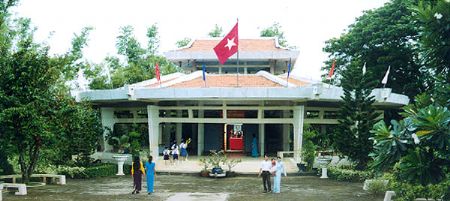There is a site in Tra Vinh Town of Tra Vinh Province, that attracts a lot of both domestic and foreign visitors when they stay in this province. Its the temple dedicated to President Ho Chi Minh. The attraction lies not only in its scenery, but also in its historical significance.
The Temp dedicated to
President Ho Chi Minh
built in
1970.nbsp;

Old Bay Cam who was
entrusted to take care
of
the Temple during
the war.

The
female guerillas who defended the Temple during the 1971-1975
period.
|
There is a site in Tra Vinh Town
of Tra Vinh Province, that attracts a lot of both domestic and foreign
visitors when they stay in this province. It's the temple dedicated to
President Ho Chi Minh. The attraction lies not only in its scenery, but
also in its historical significance.
The temple was built in 1970, one
year after the death of the President in September 1969. At that time, the
Vietnam war, waged by the American imperialists, was at its peak.
Construction of the temple was really a marvel, undertaken by the local
people to honour their beloved President and to show the strong commitment
to take back independence as was his wish throughout his life time.
When President Ho Chi Minh died, the
foreign aggressors and the South Vietnam administration used loud speakers
to disseminate negative information, in an attempt to destroy the will of
the Vietnamese army and people. However, their attempt failed, because it
further fostered the Vietnamese people's confidence in their final
victory.
A temple was built in Vinh Loc hamlet
of Long Duc village, a "steel land" in Tra Vinh Town, which experienced a
hard life throughout the anti-French and US resistance wars. The village
was only 4 kilometres from the Vinh Binh (the name of Tra Vinh before
liberation) provincial puppet administration's head office, and 1,500m
from an US military base, equipped with modern facilities and an airport
with fighter jets, bombers, and scout planes. The temple was located in an
area just 300m away from an enemy's post and within range of their
artillery. That's why, construction material and facilities were
transported by the villagers to the site during the night and by secret
other means. Despite all those difficulties, construction of the temple
started on March 10, 1970 and the temple was inaugurated on January 31,
1971.
|

Tra Vinh children paying
homage to the President.
|
The temple is in a
square shape, with each side 4m long and is surrounded with green bamboo
trees.The presence of the temple right on the site which experienced
fierce bombing and shelling by the enemy, helped highlight the local
people's spirit, but caused worry for the enemy. During the war, they
staged hundreds of mopping up operations and fired thousands of artillery
rounds from war ships and bombed from the air. The temple was destroyed
twice. In return, nearly 500 enemy troops, equipped with modern weapons
and aircraft, were killed by Long Duc villagers and army forces, who were
equipped with only rudimentary weapons. More than 10 martyrs died and
dozens of people were wounded during the fight to defend the temple. In
the historic Ho Chi Minh Campaign in 1975, before marching to the front,
the local liberation soldiers gave an oath at the temple, swearing to
fight for the Homeland. Tra Vinh Province was liberated on April 30, 1975,
the same day as Saigon and was among the first areas to be liberated in
the Cuu Long (Mekong) river delta.
After liberation,
according to the local people's desire, the provincial authorities ordered
the restoration and preservation of the temple. Nearby the temple, several
buildings were established, making the whole complex into a historical and
cultural site on an area of 7 hectares.
Rebuilt according to its original architecture, the temple is sheltered
with a roof in the shape of a lotus flower.
The Temple
dedicated to President Ho Chi Minh is ardent proof of Tra Vinh people's
respect and love for the President. With its historical and sentimental
value, the temple has been recognised as a national historical and
cultural site.
Professor Tran Van
Giau, when visiting the temple, noted in the visitors' notebook: "The
temple is small, but it reflects the Long Duc people's strong will.
Visiting the temple, we feel as if our beloved President is here with us.
Time and weather may fade the temple's appearance, but the high spirit for
fighting of Long Duc people is forever bright, like the sun that shines on
this land."
By
Tien Dung - Le
Cuong
nbsp;
nbsp;
nbsp;
Tien Dung - Le Cuong